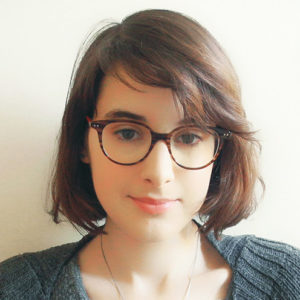 On Friday September 13th 2023, Louise DESPLAT from SPINTEC will give us a seminar at 11:00 entitled :
On Friday September 13th 2023, Louise DESPLAT from SPINTEC will give us a seminar at 11:00 entitled :
Atomistic exploration of topological states in ultrathin magnetic films and nanopillars
Place : IRIG/SPINTEC, auditorium 445 CEA Building 10.05 (access to CEA requires an entry authorization. Request it before September 04th at admin.spintec@cea.fr)
Video conference : https://univ-grenoble-alpes-fr.zoom.us/j/98769867024?pwd=dXNnT3RMeThjYStybGVQSUN0TVdJdz09
Meeting ID: 987 6986 7024
Passcode: 025918
Abstract : In this talk, we first investigate the mechanisms that govern the thermal stability of two technologically relevant systems: magnetic skyrmions, envisioned as information carriers in novel spintronics devices, and nanopillars, as used in magnetic tunnel junctions (MTJs) for data storage, and currently envisaged as stochastic p-bits for unconventional computing schemes. To do so, we combine the Kramers framework and a path sampling scheme in atomistic simulations.
In skyrmions, we find that their internal modes of deformation lead to a stabilizing entropic contribution to the Arrhenius prefactor [1]. On the other hand, in nanopillars, the domain-wall mediated magnetization reversal yields a large, destabilizing entropic contribution to the prefactor, which scales like an exponential of the activation energy [2]. Our simulations show good agreement with experimental measurements carried out on 50 nm diameter perpendicular MTJs, with mean dwell times down to the nanosecond [3]. We explain this observation with very low Arrhenius prefactors in the fs range. In both cases, we challenge the common assumption of a constant, 1 ns attempt time in these systems.
We then explore the Eigenmodes of periodic topological phases in ultrathin films [4], with potential applications in nanomagnonics and wave electronics. We compare the skyrmion lattice (skX) of the prototype system Pd/Fe/Ir(111), with Fe/Ir(111), host of the nanoskX. While we find higher order modes of deformation for skyrmions in Pd/Fe/Ir, we show how a distinct stabilization mechanism dominated by the 4-spin interaction in Fe/Ir leads to fundamentally different states.
Last, we look at the electric field control of skyrmions, a compelling low-power alternative to their manipulation via electric currents. We show how an electric field can induce a DMI-like Rashba contribution in metallic ultrathin films, and we exploit this effect in dynamics simulations combined with first principles calculations to demonstrate antiferromagnetic skyrmion nucleation at the 100 fs scale [5].
- Desplat et al. PRB 98, 134407 (2018) ; Desplat et al. PRB 99, 174409 (2019) ; Desplat et al. PRB 101, 060403(R) (2020)
- Desplat & Kim, PRL 125, 107201 (2020) ; Desplat & Kim, PR Appl. 14, 064064 (2020)
- Soumah, Desplat et al. arXiv:2402.03452 (2024)
- Desplat & Dupe, PRB 107, 144415 (2023) ; Yang, Desplat, et al, (2024), npj Quant. Mater. 9, 54 (2024)
- Desplat et al., PRB 104 (6), L060409 (2021)
Biography: Louise Desplat obtained her PhD from the University of Glasgow, UK, on the thermal stability of metastable magnetic skyrmions, under the co-supervision of Robert L. Stamps, and Joo-Von Kim from C2N/University Paris-Saclay. She was then employed for a two-year Postdoc at the University of Strasbourg, France, working with Bertrand Dupé and Paul-Antoine Hervieux on electric-field control of skyrmions, before obtaining a two-year fellowship at the University of Liège, Belgium, where she investigated periodic nanomagnetic phases, such as skyrmion lattices. She has recently been recruited as a CNRS researcher in SPINTEC, Grenoble, where she began collaborating with the group of Philippe Talatchian for unconventional computing schemes that leverage thermal noise for computation.




